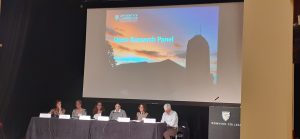Lorraine and Olivia started working as Scholarly Communication Support in the Open Access team at the Office of Scholarly Communication (OSC) in the University Library this summer. In this interview, they share their experience of starting a new role in the field of open access, from the perspective of their respective backgrounds in academia and publishing.
What does working in Scholarly Communication Support entail and what are your responsibilities in this role?
For the first few months joining the Open Access team we both started looking at “Fast Track deposits”, the simplest route of depositing author’s manuscripts into Apollo, the University of Cambridge institutional repository. This system allows the team to process items more quickly than the manual Apollo deposit. Since its launch in September 2018, it has considerably helped to reduce the workload as manuscript submission for archiving in Apollo continues to increase in view of the upcoming REF2021. On a daily basis, we also deal with queries from tickets created on the Open Access Helpdesk, contacting authors and publishers when further information is required and manually depositing manuscripts on Apollo while also updating their records on Symplectic Elements, the University’s research information management system.
Olivia and I are now being trained to respond to researchers’ funding queries and to process invoices for journals’ open access fees from the RCUK and COAF block grants. In order to do this we have had to learn more in depth about open access requirements and Research Councils’ funder requirements.
More recently, we have been working with Units of Assessment to support them with the open access component for REF (Research Excellence Framework) compliance, attending training sessions and reviewing Unit of Assessment outputs for eligibility. This has involved researching and interpreting the REF 2021 requirements for open access to disseminate effectively to academics and administrators. It has been illuminating to gain the perspective of different faculties, the way that they have to engage with REF, and their grapples with open access compliance.
What are your respective backgrounds and how did you decide to start working in OA?
Lorraine: Prior to working in open access, I completed a PhD in History of Art in Cambridge, looking at specific intersections between early modern artworks, medicine, and theories of the imagination. I also worked as a postdoctoral researcher at CRASSH (Centre for Research in the arts, social sciences and humanities) for one year.
I first became interested in OA and Scholarly Communication during my studies as a PhD representative for my peers in History of Art between 2017 and2018, the year that electronic deposits of PhD theses via Apollo became a requirement. There were anxieties from my peers around this new requirement, especially in relation to the open access feature: what would this mean for publishing their first monographs from their PhD thesis as Early Career Researchers? Would publishers still be interested in their work after it had been made OA? And, especially, what about the hundreds of copyrighted images present in their theses? It would have taken months to obtain permission to reproduce all of those images. During this time, I liaised with the OSC, the head of the AHRC Doctoral Training Partnership programme (as part of the RCUK, the AHRC also has its own open access requirements that apply to PhDs), communicated with faculty staff during meetings, and reported the advice I had gathered to my peers. I see this new position in the OSC Open Access team as an excellent opportunity to understand better what happens behind the scenes of an institutional repository and gain more knowledge about the broader picture of open access in academic research.
Olivia: I left academic publishing with a sense that the model was broken. Expensive paywalls restrict access to those seeking to access information and academics were becoming increasingly disenchanted with the publishing model. These issues particularly hit home following two separate instances. The first, a letter sent to the publisher by a prisoner seeking further information on a criminology text, one which was prohibitively expensive and inaccessible to such an individual. The second, a cuttingly written forward by an academic around monograph publishing and the ivory towers in which university elites and academic publishers co-exist.
Academic publishing very much feels like the other side of what I am doing with open access, making research as freely and widely available as possible.
How do you think your past experiences have helped you to have the necessary skills for working in OA?
Lorraine: As a Cambridge student, I acquired a good knowledge of Cambridge’s unique research and teaching landscape (Schools, Faculties, Departments, Colleges, Research centres, etc.). My academic background also meant that I had hands-on understanding about the process of research, publishing in a peer-reviewed journal, and even submitting my outputs through Symplectic Elements. These were really helpful starting my new role: understanding how researchers work is crucial in scholarly communication and definitely helps me to advise and communicate with researchers better. I am, for instance, particularly interested in the relationship between open access and third-party copyright (especially images from cultural heritage institutions, i.e. galleries, libraries, archives and museums) and the challenges it brings to researchers in the Arts and Humanities.
Olivia: I have found my previous work in publishing an asset working in open access because of my knowledge of the editorial and production process as well as publishing revenue models. I am familiar with the time scales for journal articles and books production as well as publishers’copyright requirements which I have found I am using on a regular basis. Working extensively with academics in a production role, I am aware of the competing pressures placed on them and their need for clear and accessible information on fulfilling publishing commitments or REF compliance.
Now that you have started your new roles, what are the tips you would give to someone interested in starting a career in OA?
Picking up from last year’s blogpost, and from our own experience: keeping up to date with developments, attention to detail, supporting academics and seeking support from the open access community are four key areas when starting in a career in OA.
Keeping up to date with developments and attention to detail
Publisher’s and funders’ open access policies change very quickly, as do the methods we adopt within the team to cope with the workflow and with the challenges brought by REF 2021. Anyone starting a career in OA needs to keep up to date with changes, be capable of doing in-depth research about those, and be comfortable admitting not knowing everything! The landscape is constantly changing and having an awareness of new proposals and initiatives makes the big picture much clearer.
Supporting academics
Give academics a break. It will take you a while to feel confident with policy and guidance and for you, it is your whole job. For the academics submitting their papers and contacting the repository, this is one small part of their role; you need to guide them through it as painlessly as possible.
Seek support
You cannot and do not know everything about open access. Luckily, there are plenty of wonderful expert colleagues who can help, so it is really important to know how to work within a team and keep building the necessary knowledge as a group.
Published 25 October 2019
Written by Lorraine de la Verpilliere, Olivia Marsh



